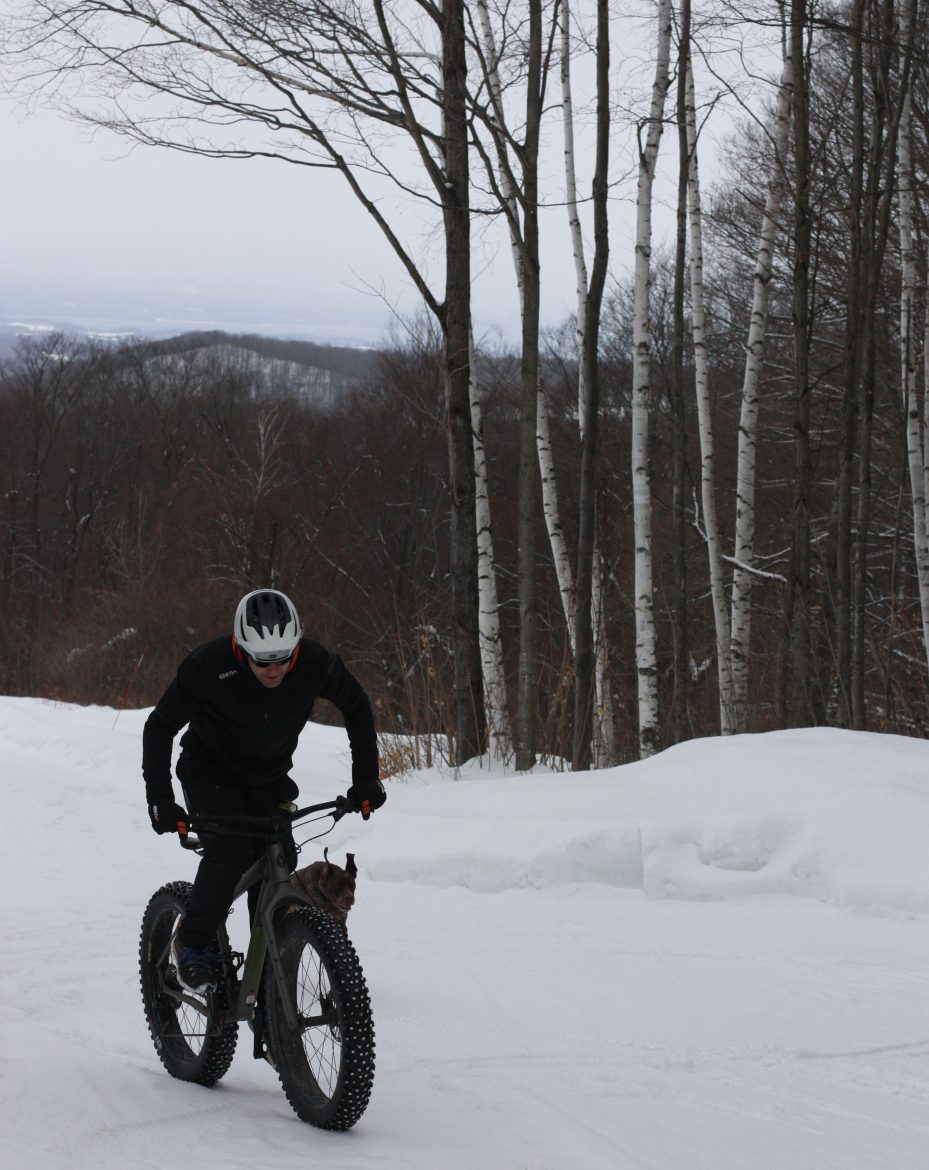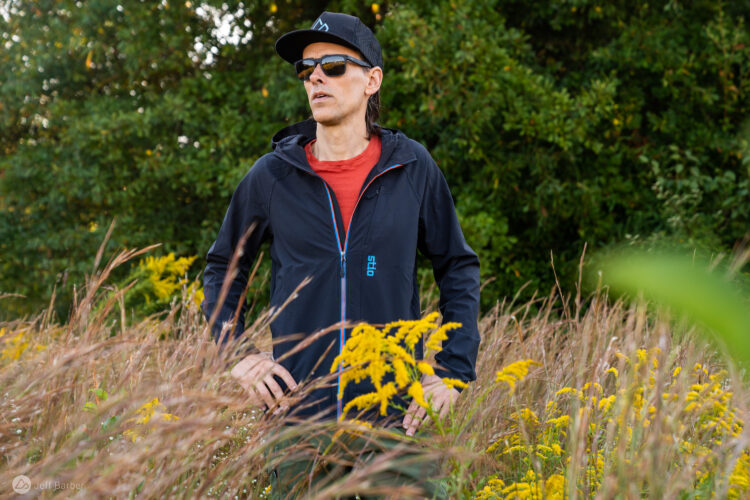
When the days are short and the temperatures below freezing, it takes a lot of motivation—and gear—to get out the door. But here’s a little secret: the woods are always warmer than the temperature displayed on your phone.
Here in Vermont we’re lucky to have a network of trails suitable for fat biking and a team of volunteers willing to groom them using a panoply of methods, from skis to snowshoes to Snowdogs—to whatever you’d call that one guy’s tire-dragging system. Given their efforts, it’d just be rude not to get out there and enjoy them. Here’s some gear I tested while riding our winter trails.
Best gear systems tested
There are a ton of companies out there making great fat-biking gear, which means you could stitch together a warm and breathable get-up without wearing the same brand twice. But a handful of companies have made a concerted effort to develop systems that integrate fit and function so seamlessly that, well, they go perfectly together. It’s probably no accident that the two brands that rose to the top in this category—Velocio and 45NRTH—hail from New England and Minnesota respectively, where freezing temperatures aren’t bolstered by sunshine or low humidity levels to boost the real-feel temp.

Velocio Alpha System
If your winter ride mantra is “matches to burn,” the Velocio Alpha system’s got you covered. This warm, lightweight, and highly breathable setup excels when working up a sweat in cold temps, so this was the kit I reached for when I knew I was going out for more than just a casual romp through the woods.
I tested the Alpha long sleeve midlayer, the softshell jacket, and the Alpha glove (the Alpha system also includes the Ultralight Rain Jacket, but if it’s raining and you’re riding groomed singletrack—you’re wrong), paired with the Zero+ Bootie, the winter wool sock, and the Zero bib tight. On extra-cold days (single digits), I added the Trail shorts on top and the Merino Mesh baselayer.
Pros: Breathability, warmth (tested down to 4°F) and an excellent ability to move moisture out and away from your body to keep you warm and dry.
Cons: It’s pricy. But Velocio has long maintained high standards for its ethical business practices, which include a commitment to using sustainable and recycled materials, fair labor practices, and an annual limited-release charitable-giving jersey campaign—the UNITY Project—that last year donated $110,000 to nonprofits aimed at stemming the impact of COVID-19.



Bottom line: Waffle weave for the win! Both the Merino Mesh baselayer and the Alpha mid-layer (featuring Polartec Alpha Direct panels and fleece-backed merino) utilize a gridded system to move sweat away from the body quickly and efficiently. Waffle weaves and gridded fleece aren’t a new concept, but they work so well—particularly when made from premium materials—that it’s hard to understand why anyone bothers to make non-gridded base or midlayers. Pair that with a DWR-treated three-layer softshell and the high-stretch/windproof Zero bib tight, and you’re good to go (fast).
45NRTH Naughtvind System



Located in Bloomington, Minnesota, the 45NRTH folks know all about frigid temps and frostbite, and that’s reflected in the Naughtvind system we tested, which can best be described as “bomb-proof but breathable.” Altogether, this is a three-piece collection consisting of the Naughtvind bibs (no chamois, $249 at REI), the Naughtvind pants ($195 at Backcountry), and the Naughtvind jacket ($295 at JensonUSA). The system utilizes a merino/poly stretch blend for warmth in the bibs, and breathable double-weave softshell material in the pants and jacket. The jacket also features gridded fleece panels under the arms to help move moisture out while keeping you warm. I also tested—and loved—the Sturmfist 5 gloves ($85 at REI), which aren’t even the warmest gloves 45NRTH makes (that’d be the Sturmfist 4), but still kept me warm down to 3°F thanks to a merino and Polartec Alpha insulation system.
Pros: 45NRTH has clearly spent a lot of time obsessing about the details, and that translates to a winter riding system that you can dial in to your exact specifications—and then adjust throughout the ride. The Naughtvind pants and jacket have mesh-lined vents seemingly everywhere—including an oversized thigh vent that lays bare a large swath of outer thigh—as well as back zips that channel air from your pockets (when opened) to your back.
But for every vent, there’s a corresponding feature that helps seal the cold and snow out, from the Cordura-reinforced tapered ankles that cinch down over boots, to the extra-high chest panel on the bibs, to the asymmetrical jacket zipper that lets you zip up fully without chin rub while still leaving room for a gaiter and hoodie underneath. Also nice: The bibs can be worn with the Naughtvind pants or solo. Our tester appreciated the three back pockets on the bibs to keep snacks (or phones) from freezing, and praised the wind, water, and abrasion-resistant panels that protected his thighs and rear from the elements


Cons: It’s pricy. And while he commended 45NRTH’s attention to detail, our tester also mused that a “Naughtvind lite” version with fewer bells and whistles would be nearly as nice. (Case in point: he never needed to open the thigh vents, because the double weave was so breathable).
Bottom line: Feature-laden, meticulously crafted, and with painstaking attention to detail, the 45NRTH Naughtvind jacket is for those riding in extreme conditions who also want to be able to dump heat fast if necessary.
The luxe combo

I frequently use the laundry room as an informal points system for gear I’m testing: If I’m constantly grabbing a piece of gear off the drying rack (bonus points for rooting through my laundry basket), I know it’s a keeper. By tracking those habits, I realized that nearly all of the gear that I loved most was wool—perhaps because its natural stink-busting properties meant I could often skip the wash cycle and go straight to the hang-dry part. After two months of steady testing, this was the gear that rose to the top.
Hat and neck gaiter: Fine-gauge merino wool (150-175 grams/square meter) kept my head and face toasty even after a sweat-inducing uphill slog. The flatlock seams on Smartwool’s Merino Sport 150 beanie (available at Amazon) are smooth under a helmet—and I loved the extra length of Wūru’s Merino Neck Gaiter 175, which, at 19 inches, is long enough to double over on the coldest days for extra warmth.

Jacket: As noted above, if it’s raining and you’re riding fat bikes, you’re doing it wrong. However, even the best riders biff into snowbanks when the trail is slippy—and that’s where the Fox Flexair Neoshell Water Jacket (currently on sale at Backcountry) really excelled during testing. Typically you get to choose between waterproofness and breathability, but thanks to a series of heat-dumping features—like extra-long pit zips, laser-cut ventilation holes under a back yoke, mesh-lined pockets, and highly breathable three-layer Polartec Neoshell fabric—this jacket was my top pick for 95% of my rides, which ranged from 4°F to about 45° before the season started. (Bonus points for durability: I took a real digger on frozen dirt in early December, and while my chin took a beating, the jacket did not.)
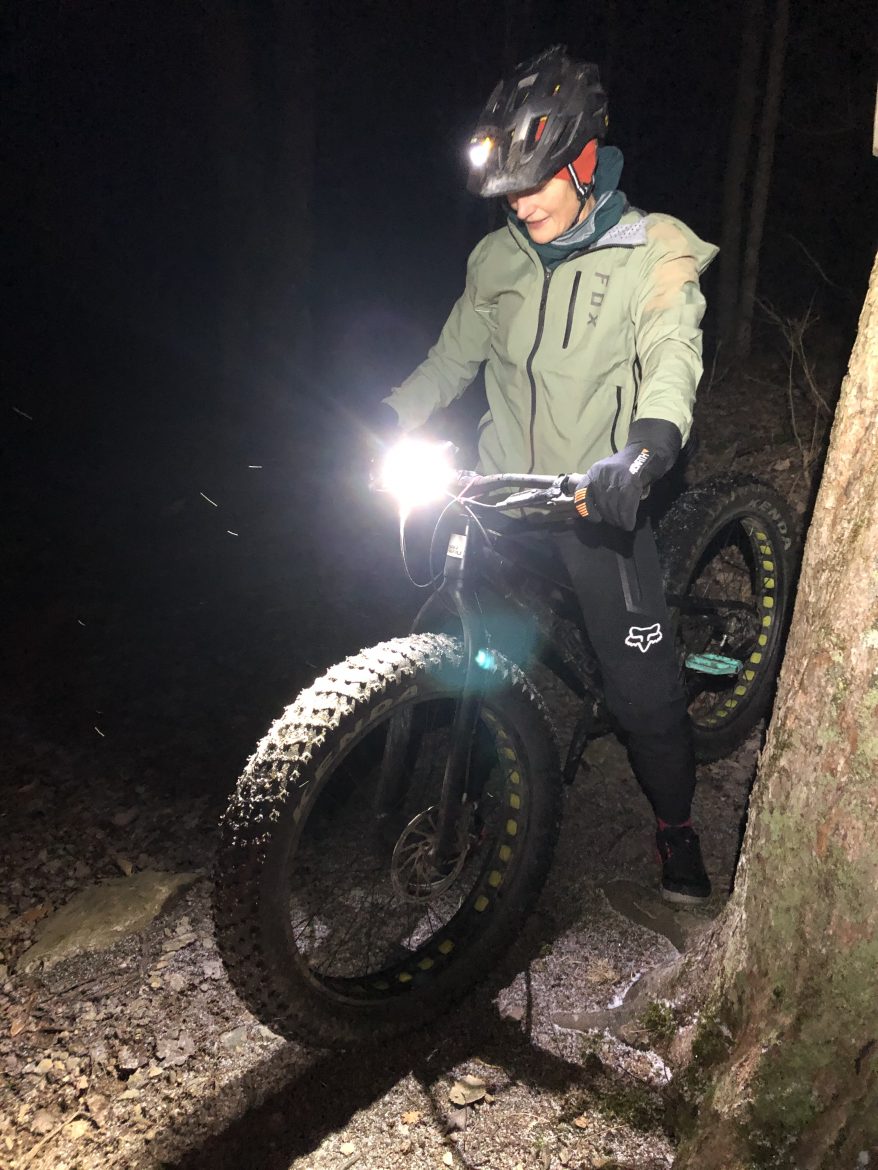


On top: I started referring to my Velocio merino mesh sleeveless baselayer as my “mithril”—that is, the lightweight battle armor forged by the dwarves in J.R.R. Tolkien’s fantasy novels—because I wore it nonstop. For days when it was 20-32°, I layered the Kitsbow’s Lory merino henley (for men, it’s the Escalator) on top. For those truly frigid days, I reached for the Intraknit Merino 200 quarter-zip from Smartwool instead, which utilizes a blend of merino and mesh ventilation to keep the moisture moving out and away from your body. Finally, I rarely left home without Kitsbow’s new Galena hoodie. A merino/Tencel blend, the Galena fits great, breathes really well—and totally eliminates that “I’m a biker wearing a funny costume” vibe.

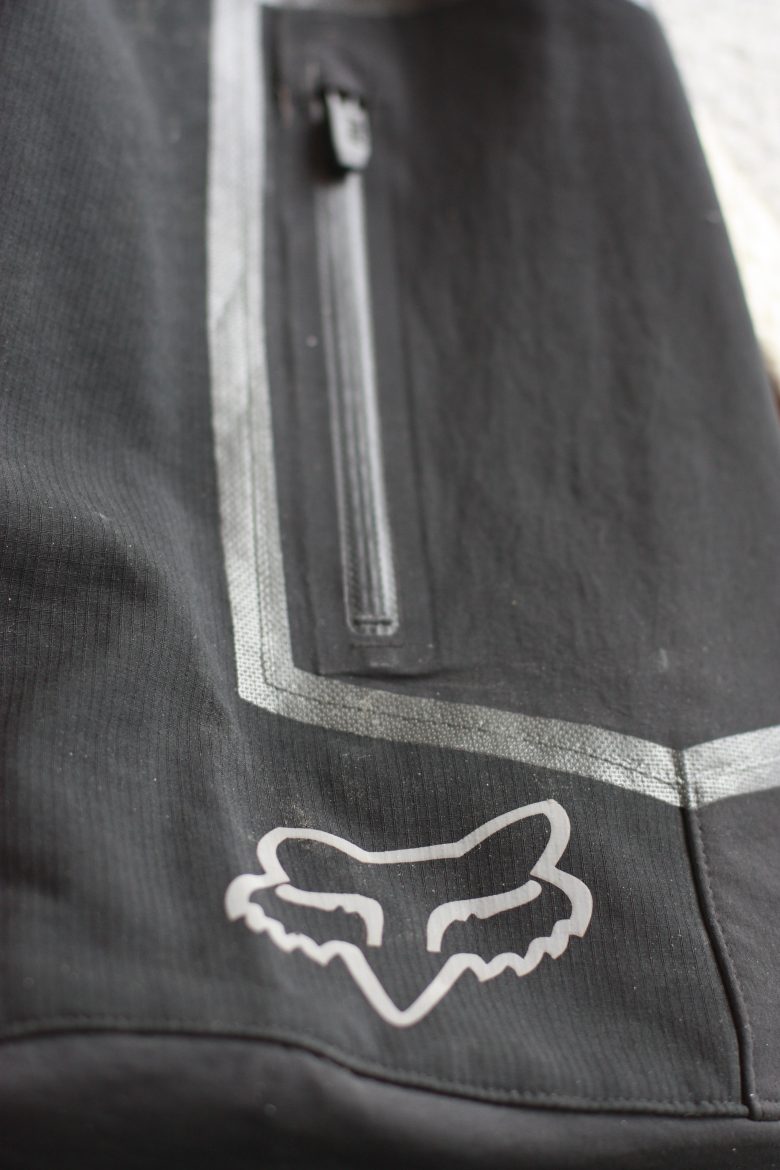

On bottom: While I loved the idea of a pair of high-quality cycling shorts or tights (Machines for Freedom makes a great pair), I kept going back to bibs, which sealed out any cold or snow leaks around the waist. However, bathroom breaks become a real issue when it’s 5° out, so I almost exclusively reached for Velocio’s Foundation bib shorts, which have super-stretchy bib straps that let you do what you need to do without taking all of your upper layers off. Topped by Fox’s Defend Fire Pant (available at Backcountry)—fleece-lined, wicking, and water-resistant cycling pants that were unbelievably tough, warm, and comfortable—I was good to go down to single digits.
Footwear: Fat bikers fall into two distinct categories: Those who enjoy being clipped in and are willing to risk wearing SPDs on icy trails, and those who prefer regular boots and flat pedals. I’m in the latter category, and preferred the ankle flex, flat sole, and waterproof/insulated vibe of the Teva Ember Commute boots (available at REI) rather than cycling-specific shoes (though several of my friends swear by the Ragnaroks, by 45NRTH.) I was also a huge fan of the Farm to Feet Damascus socks (available at Amazon), which pack a ton of wool into a slim-fitting sock that doesn’t ride down out on the trail.
The value combo
There are two main barriers to entry for fat biking: having the right conditions to do it in, and the cost to get yourself out there. The gear has to be both warm and breathable, which often translates to it being eyeball-poppingly expensive. But while we lovingly referred to this section of the test as the “dirtbag category,” the pieces highlighted here definitely aren’t junk; rather, they’re either something you already have in your closet (i.e., a wool sweater from the Gap closeout rack), or a high-quality multiuse piece that’s budget-friendly because it transcends seasons or sports. So here’s a list of our favorite multifunctional pieces that net excellent cost-per-wear calculations.

Helmet: If you’re reading this, you probably already have one. Same thing with sunglasses and a lightweight beanie.
Jacket: The Flylow Davis Jacket (45% off at Backcountry at time of publication) is designed with bikes in mind, but our tester wore it hiking, Nordic skiing, splitboarding, snowboarding, and mountain biking before making it an essential part of his fat-biking wardrobe. He praised its breathability, but noted that it could still take the edge off the wind. “It doesn’t have that plasticky feel to it, so you won’t get clammy inside of it,” he says. “Also, the cut is really nice.”
On top: A basic polypropylene long-sleeve layer under a clearance-rack wool sweater kept our tester plenty warm, as the polypro moves moisture out, and the wool insulates even when wet.
Gloves: Kinco has been making work gloves for 40 years—long enough that plenty of outdoors companies have started to copy their style. Pick up a pair of premium pigskins for $20 at the hardware store and when you’re done riding you can stack wood wearing ‘em too. Bonus: Rub on some mink oil or Sno-Seal for added water protection.
On bottom: The Bontrager Velocis un-padded softshell bib tights pack a lot of features in for $140. For $20 more you can get a version with a chamois, but you might not want to, as the pad is the first thing to deteriorate with repeat washings. You can often wring the most value out of bib tights by buying unpadded ones and pairing them with bib liners or bib shorts, as our tester did. The front of the Velocis tight (and the rear panel) is all wind- and water-resistant softshell material that’s paired with stretchy, breathable fleece elsewhere for a warm and weather-resistant ride. Our tester added the Fox Defend Pro Water Shorts (available at JensonUSA) on top for a combo that he said was pretty bomber—and said he looked forward to employing the shorts for early-season gravel rides, too. In his words, “If you can keep the nether regions warm and dry, you can endure and even enjoy pretty much any adverse weather scenario.”

Socks: At $26 per pair, the Park City over-the-calf socks from Farm to Feet aren’t dirt-cheap ($25.95 at Backcountry)—but our tester has been rotating through a small crop of Farm to Feet socks since 2015, and says they still look (and feel) as good as these ones did right out of the box. Made in the U.S from U.S.-grown merino wool, the Park City socks are Farm to Feet’s warmest offering, but aren’t bulky under boots.
Boots: Any light hiker with a flexible ankle and a flexible enough sole to wrap around pedals will work. Look for something with enough tread to avoid slipping around if walking, but not so much you can’t move your feet around on the pedals.
Accessories and Après
Do you need these picks to fat bike? Absolutely not. But they improved our testers’ lives in measurable ways, and they might be the difference between a warm, comfortable ride and a death march.
For your hands: Many pogies can feel big and cumbersome on your handlebars, but the 45NRTH Draugenklaw pogies take a lightweight approach to the traditional pogie—and they’re great. I paired these with the shoulder season-rated Nokken gloves (available at REI) down to single digits.


For your eyes: I loved the Roka CP sunglasses for warmer days (HC Ion Mirror is great on snow), but I was blown away by the un-foggable Julbo Quickshift MTB goggles (available from evo), which allow you to remove the lower section of the frame for more airflow. The optics are also stellar.


For your body: I detest the taste of hot plastic, but it’s the only way I know to keep my water from freezing while fat biking. The Bivo One stainless steel bike bottle isn’t insulated or vacuum-sealed—yet—but it keeps the hot-plastic taste at bay (and looks good doing it).
For your handlebars: I tucked spare gloves, an extra buff, snacks, and reusable hand warmers into a handmade-in-the-USA MoosePacks handlebar bag—and had zero regrets about carrying any of it.



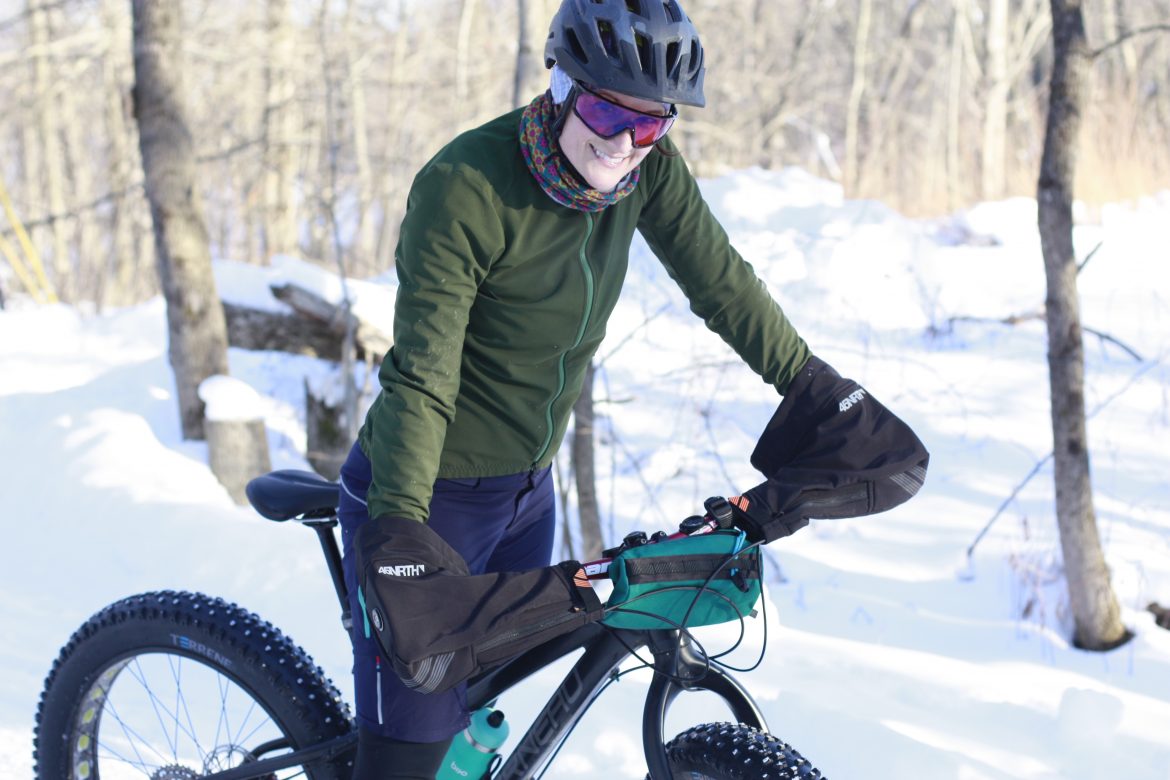
For your après-ride tailgate: Stio’s Buckhorn Insulated Snap Shirt is a welcome alternative to my puffy jacket, and I loved the drop hem and insulated pockets. As a bonus, the nylon-lined sleeves are roomy enough—and slippery enough—to ease on over all of my layers.
For your pup: Our shorthaired French Pointer dog (Larry) gets super-stoked as soon as you bring out his Kurgo Loft dog jacket (available at Moosejaw). It’s good for his morale, it keeps the shivers at bay, and he wears the Liberty Floral print with pride. What’s not to love?













